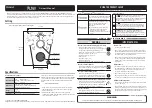
Friabilimeter
operating instructions
© 2016 – Pfeuffer GmbH
Revision 7
Page 25 of 48
Evaluation
7.7
Determination of hyaline
The hard malt components are distinguished between part hyaline and whole hyaline. Increasing
components of whole hyaline grains reduce the brewing value.
All grains which are larger than ¾ of a grain are sorted from the glassy malt constituents manually. This
fraction referred back to 100% is considered as whole hyaline.
Shake the contents of the sieve drum onto a sorting sieve of 2.2 mm slit width for 60 seconds. The
fraction left on the sieve is considered as part hyaline.
Meaning of hyaline
Excessive hyaline has an adverse effect on the mashing and lautering process. During the brewing
process problems will arise during the wort clarification, fermentation, maturing and filtration.
Figure 20: Fractions following the investigation
Two fractions are available following the investigation:
•
Content of the sieve drum, glassy constituents (mass
A
)
•
Content of the collecting tray, friable constituents
The friable constituents are not relevant for the further
investigation and can be disposed of.
7.7.1
Friability M
Weigh the mass
A
to an accuracy of two decimal places.
Calculation formula:
M = 100 – (2 x A)
Sample calculation:
Mass A = 8.32 g
M = 100 – (2 x 8.32 g)
M = 83 %
M = Friability in percent (%) - rounded to the nearest whole number
A = Mass of the fraction remaining in the sieve drum (glassy constituents) in grams.
7.7.2
Whole hyaline (whole grains) WH
Manually separate out the whole grains from the mass
A
= mass
B
.
Whole grains are also grains which are larger than ¾ of a grain.
Weigh the mass
B
to an accuracy of two decimal places.
Calculation formula:
WH = 2 x B
Sample calculation:
Mass B = 0.76 g
WH = 2 x 0.76 g
WH = 1.5 %
WH = Whole hyaline in percent (%) - stated to one decimal place
B = Mass of the manually separated out whole grains in grams.
















































